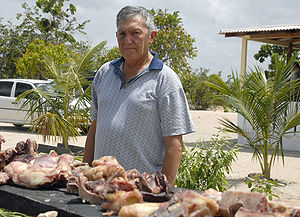| This article needs additional citations for verification. Please help improve this article by adding citations to reliable sources. Unsourced material may be challenged and removed. Find sources: "search keyword(s)" – news · newspapers · books · scholar · JSTOR (August 2023) (Learn how and when to remove this message) |


Carne-de-sol ([ˈkaʁni dʒi ˈsɔw], Portuguese for "sun meat"), or jabá ([ʒaˈba]) is a dish from Northeastern Brazil. It is made by cutting beef into "blankets" which are then lightly salted. The blankets are then placed outside in a dry and ventilated area to cure.
Carne-de-sol is sometimes fried and served as a hamburger, or baked in the oven with cream or, more traditionally, prepared as savory paçoca.
Its origin is attributed to the sertanejos (people who live in the semi-arid countryside), who developed this local recipe to preserve meat. Nowadays, the dish is traditional and typical of the entire Northeast Region of Brazil, and is served in restaurants all across the country.
See also
References
- Gosto, Brasil a (2021-12-21). "Carne de Sol". Instituto Brasil a Gosto. Retrieved 2023-08-18.
This Brazilian cuisine–related article is a stub. You can help Misplaced Pages by expanding it. |
This meat-related article is a stub. You can help Misplaced Pages by expanding it. |